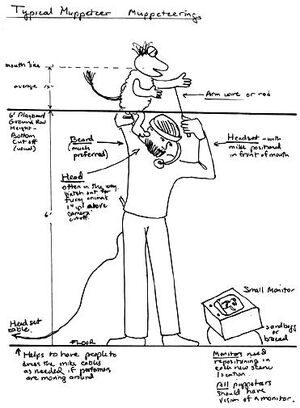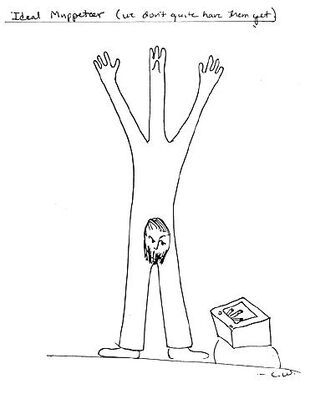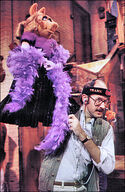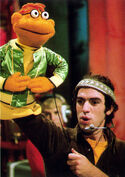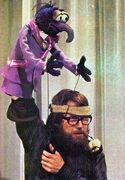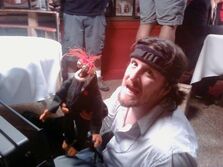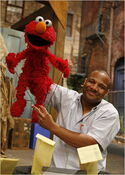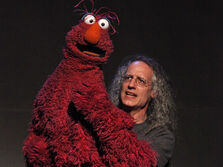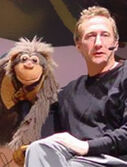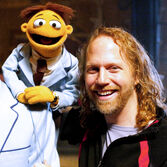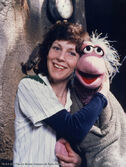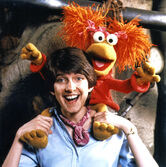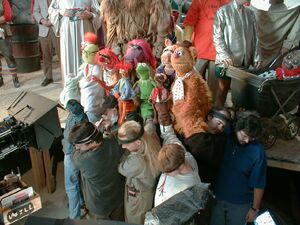
Muppeteers on the set of Muppets from Space
A Muppeteer, also known as a Muppet performer, is a puppeteer for the Muppets. The Muppeteers manipulate the puppets, provide voices, and otherwise brings life to the various characters.
Caroly Wilcox prepared a 1983 memo (during pre-production for Fraggle Rock) which illustrated and defined key aspects of the Muppet way of performing. As several of the new Fraggle Rock puppeteers came from non-puppetry backgrounds (mime, stage acting, stand-up comedy), the memo addressed some key factors which differed between performing solo or with a supporting cast of live actors. These included use and awareness of the monitor and how much the camera will display, physical position and using mics and rods, and other details. Wilcox indulged her sense of humor by remarking that the head is "often in the way;" that for puppeteering, a beard is "much preferred"; and illustrating a three-armed person (with head at the bottom to better watch the monitor) as the "ideal Muppeteer."[1]
According to Henson biographer Brian Jay Jones, Jim Henson did not like the term "Muppeteer":
Technique
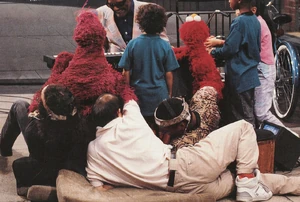
Muppeteers at work on Sesame Street.
Since the early days of Sam and Friends, Jim Henson and his colleagues employed different techniques to bring their characters to life. In most cases, the puppeteers hold the puppets over their heads. Muppeteers work in several different ways to get the effect that is needed on the television screen. Usually, Muppeteers perform their characters above their heads, standing. All of the sets are raised about 5' for this reason.
To see their performance, they watch what is being recorded on a monitor, or a small television, which allows them to see what the audience will see. However, it takes a long time to get used to working in this manner, since certain things are reversed in the monitors (If a puppet turns left, it looks as if it's turning right on the monitor). Muppeteers often tape their scripts to these monitors to read off of as well.
Hand-Rod Muppets
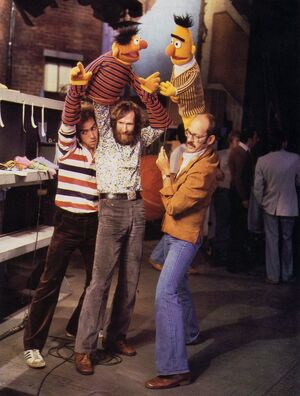
Jim Henson, with Richard Hunt right-handing, performs Ernie (a live-hand Muppet) while Frank Oz performs Bert (a hand-rod Muppet).
A hand-rod puppet is a puppet which is controlled by both hands. The puppeteer's dominant hand goes into the head of the puppet, operating the mouth, and at times, facial features. The puppeteer's less dominant hand controls the "arm rods", thin rods connected to the puppet's hand or hands. Examples of this type of puppet are Kermit the Frog, Miss Piggy, Gonzo, Bert, Elmo, Grover, the Fraggles, and others.
Live-Hand Muppets
The hands for these puppets are actually gloves, which the puppeteer puts his or her less dominant hand into. This way, the puppet is able to manipulate objects, like picking things up or playing a piano. These puppets tend to be large to stay in proportion with the large human-sized hands. Since the lead puppeteer has one hand in the head and the other hand in one of the puppet's arms, another puppeteer is usually used to operate the other hand (or sometimes both, in more complicated scenes). Examples of this type of puppet are Cookie Monster, Fozzie Bear, Ernie, The Swedish Chef, Rowlf the Dog, Dr. Bunsen Honeydew, Beaker, Count von Count and many others.
Right-handing
With live-hand Muppets, since the principal puppeteer often has their right arm in the puppet's head, they will use their left hand to manipulate the puppet's left arm. As such, a second puppeteer is needed to perform the puppet's right hand. Many Muppet performers get their start "right-handing" characters.
Full-Bodied Muppets
Full-Bodied Muppets are large-scale characters who combine elements of puppetry and costumery. Examples of this type of puppet include Big Bird, Sweetums, the Gorgs, Thog, Mr. Snuffleupagus, Barkley, and others.
Recruitment and training
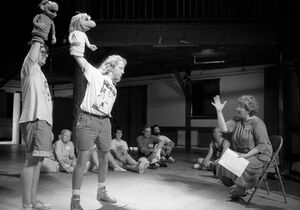
Jane Henson instructing future Muppeteers Tim Lagasse and Peter Linz at a workshop at the O'Neill Puppetry Conference in 1991.
Muppeteers generally build their skills through apprenticeship, working their way up within the Muppet ranks—typically starting with assisting other performers, right-handing live-hand puppets, performing background characters and assisting with crowd scenes.
Muppeteer workshops have been held throughout the years by the Henson Company and Sesame Workshop to find and foster new up-and-coming puppeteers. Muppeteers who have been discovered through workshops include John Tartaglia, Fran Brill, Matt Vogel, Eric Jacobson, Richard Hunt, Pam Arciero, Martin P. Robinson, and several others.
For the international co-productions of Sesame Street, Sesame Workshop often sends their veteran puppeteers (including Caroll Spinney, Kevin Clash, Martin P. Robinson, and Peter Linz) to train the international performers in the art of Muppet-style puppeteering. In 2005, the Walt Disney Company held open auditions for Muppet performers.
Some of the early Muppeteers—such as Jerry Juhl, Frank Oz and Caroll Spinney—were discovered by Jim Henson at the Puppeteers of America festivals.
Major Performers
For a full list of performers, see Muppet Performers.
Sources
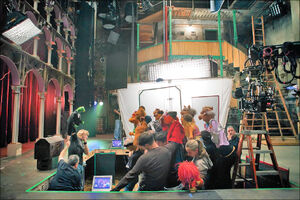
Muppeteers on the set of The Muppets.
- ↑ Muppet Musings by Matthew Smith. February 25, 2011.
- ↑ Jim Henson: The Biography by Brian Jay Jones (pages 373-374)

